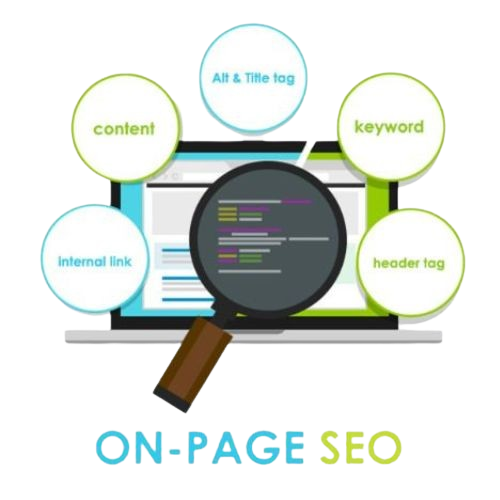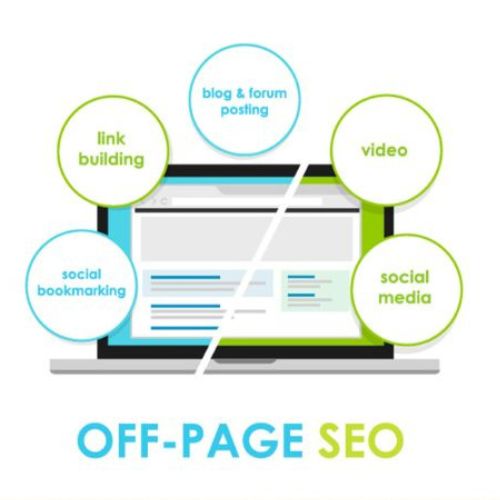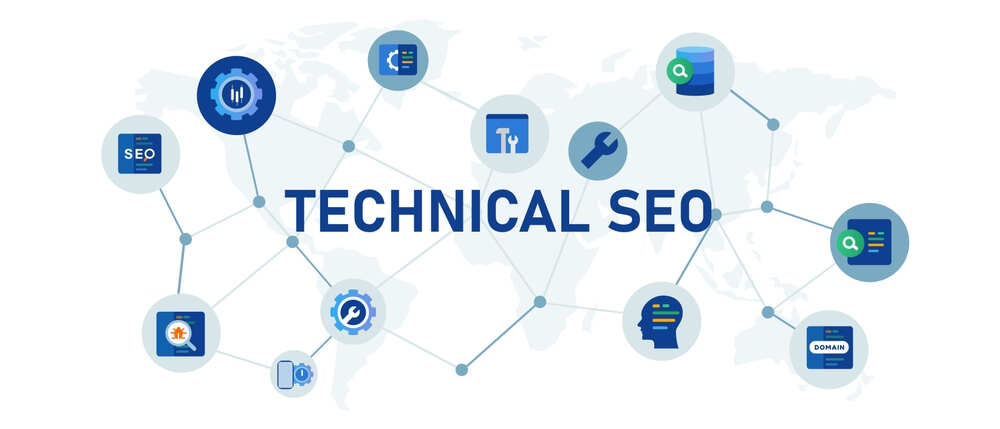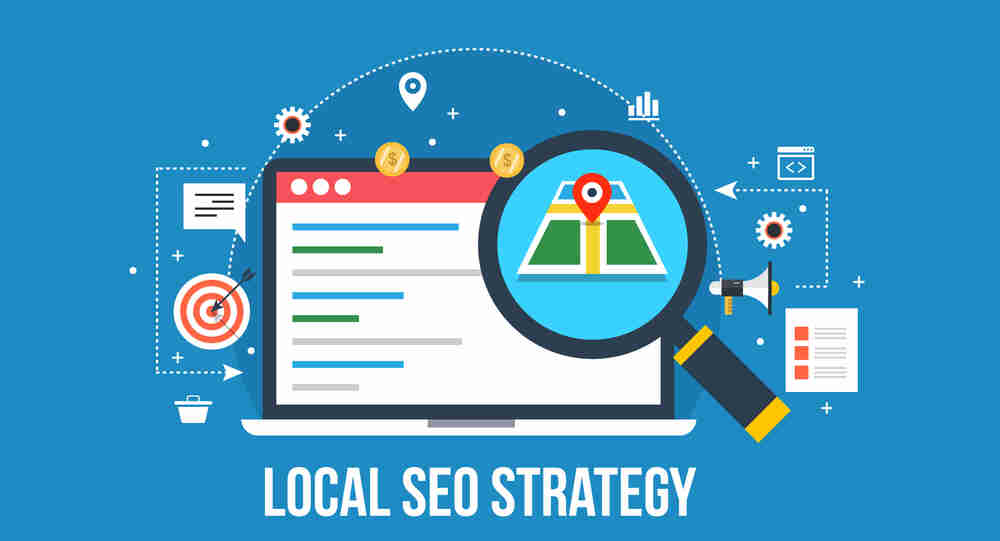
What is SEO (Search Engine Optimization)?
SEO, or Search Engine Optimization, is a set of practices aimed at enhancing a website’s visibility on search engines like Google, Bing, and Yahoo. The primary goal of SEO is to improve a website’s organic (non-paid) search ranking. SEO is like the secret sauce for your website’s visibility. It stands for Search Engine Optimization, a fancy term for making your online content appealing to search engines like Google. Think of it as the wizardry that helps your website shine when someone is typing away in the search bar. It’s not just about climbing search rankings; it’s about being the star everyone is talking about. Ready to make your website the talk of the town? That’s where SEO comes in!
Types of SEO
On-page SEO
Off-page SEO
Technical SEO
Local SEO
On-page SEO
The process of optimizing webpages and their content for search engines and users is known as on-page SEO or on-site SEO. It can increase a page’s Google ranking and increase organic traffic. Optimizing for search intent, title tags, internal links, and URLs are common on-page SEO activities.

Keyword Research
Identify relevant keywords for your content. Use tools like Google Keyword Planner, SEMrush, or Ahrefs to find relevant and high-traffic keywords.
Title Tags
Create unique and compelling title tags for each page. Include the target keyword near the beginning of the title. Keep titles within the recommended character limit (around 50-60 characters).
Meta Descriptions
Craft compelling meta descriptions that summarize the page content. Include the target keyword and encourage click-through.
URL Structure
Create SEO-friendly URLs that include relevant keywords. Use hyphens to separate words and keep URLs concise.
Header Tags (H1, H2, H3, etc.)
Use header tags to structure your content. Include the target keyword in the main heading (H1) and use subheadings (H2, H3) as needed.
Content Quality
Produce high-quality, relevant, and engaging content. Prioritize user experience and readability. Use multimedia elements such as images and videos to enhance content.
Keyword Placement
Incorporate the target keyword naturally within the content. Avoid keyword stuffing; focus on providing valuable information.
Internal Linking
Link to other relevant pages within your website. Use descriptive anchor text for internal links.
Image Optimization
Compress and optimize images to reduce page load times. Use descriptive file names and include alt text with relevant keywords.
Page Speed
Ensure fast page loading times to improve user experience. Use tools like Google PageSpeed Insights to identify and address performance issues.
Mobile Optimization
Ensure your website is mobile-friendly.Google considers mobile-friendliness as a ranking factor.
Schema Markup
Implement schema markup to provide search engines with additional information about your content.
Social Media Integration
Integrate social sharing buttons to encourage sharing.
User Engagement
Encourage user engagement through comments, social shares, and other interactions. Higher engagement can signal to search engines that your content is valuable.
SSL Encryption
Secure your website with SSL (Secure Sockets Layer) to create a secure connection. Google considers HTTPS as a ranking factor.
Page Structure and Readability
Use short paragraphs, bullet points, and clear headings to improve readability. Organize content logically to help both users and search engines understand the structure.
Canonical Tags
Use canonical tags to indicate the preferred version of a page if there are duplicate or similar content issues.
Robots.txt and XML Sitemap
Ensure that your robots.txt file allows search engines to crawl important pages. Create and submit an XML sitemap to help search engines index your site more efficiently.
Monitoring and Analytics
Use tools like Google Analytics and Google Search Console to monitor your website’s performance. Analyze user behavior, track keyword rankings, and identify areas for improvement.
Accessibility
Ensure your website is accessible to users with disabilities. Use descriptive text for links and provide text alternatives for non-text content.
Avoid Duplicate Content
Minimize duplicate content issues to prevent confusion for search engines. Use 301 redirects or canonical tags to consolidate similar content.
Quality Outbound Links
Include relevant and authoritative outbound links to enhance the credibility of your content.
Stay Informed
Keep yourself updated on changes in search engine algorithms and SEO best practices. Adapt your on-page SEO strategies based on evolving trends.
On-page SEO (search engine optimization) is an ongoing process, and staying proactive in optimizing your content will contribute to long-term success in search engine rankings. Regularly evaluate your website’s performance and make adjustments as needed to maintain and improve your position in search results.
Off-page SEO
In the dynamic world of online marketing, Off-Page SEO stands as a fundamental pillar that can significantly impact the success of your business. To comprehend its essence, let’s delve into what Off-Page SEO is and explore how it functions to enhance your online presence and foster business growth.

What is Off-Page SEO?
Off-page SEO, often referred to as “off-site SEO,” encompasses all the activities undertaken outside your website to improve its visibility and credibility on the internet. While On-Page SEO deals with optimizing the content and structure of your site, Off-Page SEO focuses on external factors that contribute to search engine ranking and overall online authority.
The core principle of Off-Page SEO revolves around the idea that search engines, like Google, interpret external signals as indicators of a website’s relevance, authority, and trustworthiness. These signals primarily come from other reputable websites, social media platforms, and online communities, influencing how search engines work and rank your website in search results.
How Off-Page SEO Works for Your Business
Backlinks – The Backbone of Off-Page SEO
At the core of Off-Page SEO lies the concept of backlinks. Backlinks refer to links originating from external websites that direct towards your site. Think of them as votes of confidence in your content. When high-quality, authoritative websites link to your pages, search engines view your content as valuable and relevant, thereby improving your search rankings.
Building a robust backlink profile involves a strategic approach. The quality surpasses quantity; one high-quality backlink from an authoritative source can be more impactful than numerous links from less reputable sites. This process involves outreach, relationship-building, and creating content that naturally attracts links.
Social Media Share
Social media has become an integral part of our daily lives, and search engines recognize its influence. Social media signals, such as likes, shares, and comments, contribute to the overall perception of your content. Engaging and shareable content on platforms like Facebook, Twitter, and LinkedIn can amplify your online reach, fostering a positive correlation with search engine rankings.
Integrating social media into your Off-Page SEO strategy involves consistent interaction with your audience. Encourage sharing, participate in relevant conversations, and create content specifically tailored for social media platforms to enhance your brand’s online presence.
Influencer Marketing
Collaborating with influencers in your industry is a strategic move that aligns with Off-Page SEO (search engine optimization) goals. Influencers, with their established audiences, can significantly impact your brand’s visibility. When influencers share or mention your content, it not only reaches a wider audience but also builds credibility and trust.
Identifying and connecting with influencers requires research and relationship-building. It’s crucial to ensure that the influencers align with your brand values and target audience to maximize the effectiveness of these partnerships.
Online Reviews and Mentions
Customer reviews and online mentions contribute to the off-site reputation of your business. Positive reviews on platforms like Yelp, Google My Business, and industry-specific review sites not only enhance your credibility but also influence local search rankings.
Encourage satisfied customers to leave reviews and monitor online conversations related to your brand. Addressing customer feedback, whether positive or negative, demonstrates transparency and commitment to customer satisfaction, further bolstering your Off-Page SEO efforts.
Guest Posting and Content Marketing
Publishing high-quality content on other reputable websites in your niche is a strategic approach to Off-Page SEO. Guest posting not only exposes your brand to new audiences but also establishes you as an authority in your industry. Focus on creating valuable, informative content that aligns with the interests of the target website’s audience.
Content marketing extends beyond guest posting. Regularly publishing engaging and shareable content on your website contributes to Off-Page SEO by attracting natural backlinks and social media attention. This continuous cycle of content creation and promotion reinforces your brand’s authority in the digital space.

Off-Page SEO is a multifaceted strategy that goes beyond the confines of your website. It involves building a digital footprint that signals to search engines that your business is reputable, trustworthy, and relevant. The synergy between backlinks, social media signals, influencer marketing, online reviews, and content marketing creates a robust Off-Page SEO framework.
As you navigate the vast landscape of digital marketing, integrating Off-Page SEO into your overall strategy can yield sustainable results. By understanding and leveraging the external factors that influence your online presence, you can position your business as a valuable resource in your industry and pave the way for long-term success.
Technical SEO
In the intricate world of digital marketing, Technical SEO stands as a pivotal force that can significantly impact the success of your business. This article aims to unravel the nuances of Technical SEO (search engine optimization), offering insights into what it encompasses and how its strategic implementation can propel your business to new heights.

What is Technical SEO?
At its core, Technical SEO involves optimizing the technical elements of your website to improve its search engine visibility and overall performance. While content quality and relevance remain crucial for SEO success, the technical aspects ensure that search engines can effectively crawl, index, and rank your website.
Key Components of Technical SEO:
Website Speed and Performance
The speed at which your website loads is a critical factor in user experience and search engine rankings. Slow-loading websites can lead to higher bounce rates and lower search rankings. Technical SEO involves optimizing images, leveraging browser caching, and utilizing content delivery networks (CDNs) to enhance website speed.
Mobile Friendliness
With the prevalence of mobile devices, search engines prioritize mobile-friendly websites. Technical SEO includes responsive web design, ensuring that your site is accessible and visually appealing across various devices. Google’s mobile-first indexing further emphasizes the importance of a seamless mobile experience.
Crawlability and Indexability
Search engines use crawlers to navigate and index web pages. Technical SEO ensures that these crawlers can efficiently access and index your website’s content. Factors such as clean URL structures, XML sitemaps, and the proper use of robots.txt contribute to effective crawlability and indexability.
Site Architecture and URL Structure
Well-organized site architecture and URL structures enhance user navigation and contribute to search engine understanding. Technical SEO involves creating a logical hierarchy for your website’s pages, making it easier for both users and search engines to find and understand your content.
Secure and Accessible Website
Security is paramount for both users and search engines. Technical SEO includes implementing HTTPS protocols, and ensuring secure data transmission. Additionally, creating an accessible website improves user experience for individuals with disabilities, aligning with modern search engine optimization best practices.
Structured Data Markup
Structured data provides context to search engines about the content on your website. By incorporating schema markup, Technical SEO helps search engines better understand the meaning of your content, potentially leading to rich snippets and enhanced visibility in search results.
How Technical SEO Works for Your Business:
Enhanced Search Engine Visibility
Technical SEO ensures that search engines can efficiently crawl and index your website’s content. When your site is easily accessible and well-structured, search engines are more likely to understand its relevance to user queries. This, in turn, can lead to higher rankings and increased visibility in search results.
Improved User Experience
The technical aspects of SEO directly impact user experience. A fast-loading, mobile-friendly website with intuitive navigation enhances user satisfaction. Positive user experiences contribute to lower bounce rates, increased engagement, and, ultimately, improved search engine rankings.
Adaptation to Algorithm Changes
Search engines continually refine their algorithms to provide the most relevant and high-quality results to users. Technical SEO ensures that your website remains adaptable to these changes. Staying abreast of algorithm updates and making necessary technical adjustments positions your business for long-term success in the ever-evolving digital landscape.
Optimized Conversion Rates
A technically optimized website not only attracts organic traffic but also contributes to higher conversion rates. Fast-loading pages, easy navigation, and secure transactions instill trust in users, encouraging them to engage with your content and convert into customers.
Global Reach and Accessibility
Technical SEO plays a vital role in expanding your business’s reach globally. By optimizing for mobile devices, implementing multilingual options, and ensuring international SEO best practices, your website can effectively cater to a diverse audience, breaking geographical barriers.
Competitive Edge
In the competitive online landscape, technical optimization can provide a distinct advantage. Websites that prioritize Technical SEO are more likely to rank higher in search results, attracting a larger share of organic traffic. This competitive edge is crucial for establishing your brand as an authority in your industry.
Technical SEO is the backbone of a well-rounded SEO strategy, laying the foundation for improved search engine rankings, user experiences, and overall online success. By investing in the technical aspects of your website, you not only align with search engine algorithms but also create a seamless and enjoyable experience for your audience.
As the digital landscape continues to evolve, businesses that prioritize Technical SEO will find themselves not only adapting to change but thriving in an environment where online visibility and user satisfaction are paramount. Consider Technical SEO as your digital infrastructure, shaping the online journey for your business and ensuring a solid foundation for sustained growth.
Local SEO
In the dynamic world of digital marketing, Local SEO emerges as a game-changer for businesses looking to establish a strong online presence within their community. This article aims to demystify the concept of Local SEO (search engine optimization), delving into what it entails and how its strategic implementation can significantly impact the success of your business in the local marketplace.
What is Local SEO?
Local SEO, or local search engine optimization, is a specialized form of SEO that focuses on optimizing a business’s online presence to attract local customers. It involves strategies and techniques aimed at improving a business’s visibility in local search results, particularly when users are searching for products or services within a specific geographic area.

Key Components of Local SEO
Google My Business (GMB) Optimization
Google My Business is a cornerstone of Local SEO. It’s a platform where businesses can create and manage their online presence, including their business information, reviews, and photos. Optimizing your GMB listing ensures accurate and up-to-date information, making it easier for local customers to find and engage with your business.
Local Citations
Citations are online mentions of your business’s name, address, and phone number (NAP). Local SEO involves building consistent and accurate citations across various online platforms, directories, and business listings. Consistency in NAP information reinforces your business’s credibility and improves its visibility in local searches.
Localized Content
Creating content that is tailored to your local audience is a crucial aspect of Local SEO. This includes incorporating local keywords, addressing local concerns, and showcasing your involvement in the community. Localized content helps your business connect with the community and signals relevance to search engines.
Online Reviews and Ratings
Customer reviews play a significant role in Local SEO. Positive reviews not only influence potential customers but also contribute to your business’s visibility in local search results. Encouraging satisfied customers to leave reviews on platforms like Google, Yelp, and other industry-specific review sites can enhance your online reputation.
Local Link Building
Building local backlinks from reputable sources within your community can boost your business’s authority in local searches. This involves engaging with local organizations, sponsoring local events, and collaborating with other businesses. Local link building reinforces your business’s connection to the community and strengthens its online presence.
Mobile Optimization
Local searches are often conducted on mobile devices. Ensuring that your website is mobile-friendly is a critical aspect of Local SEO. Google prioritizes mobile-friendly websites in local search results, making mobile optimization essential for reaching local customers on the go.
How Local SEO Works for Your Business
Increased Local Visibility
The primary goal of Local SEO is to enhance your business’s visibility in local search results. When users in your area search for products or services related to your business, a well-optimized Local SEO strategy increases the likelihood of your business appearing prominently in the search results, leading to more visibility and potential customer interactions.
Targeted Local Traffic
Local SEO ensures that your business attracts relevant local traffic – people who are more likely to convert into customers. By optimizing for local keywords and geographical modifiers, your website becomes more aligned with the search intent of users in your area, resulting in targeted traffic that is genuinely interested in your offerings.
Improved Customer Trust and Credibility
A well-managed Google My Business profile with positive reviews, accurate information, and engaging content builds trust with potential customers. Local SEO enhances your business’s online reputation, positioning it as a credible and reliable choice within the local community.
Competitive Edge in Local Markets
In fiercely competitive local markets, Local SEO can provide a significant edge. Businesses that invest in local optimization are more likely to appear in local map packs, local carousel results, and other prominent positions in local search results. This visibility can set your business apart from competitors and attract a larger share of local customers.
Enhanced Foot Traffic to Physical Locations
For businesses with physical locations, Local search engine optimization can drive foot traffic to brick-and-mortar establishments. Local searches often include phrases like “near me” or “close by,” indicating a user’s intention to visit a local business physically. Optimizing for such local intent ensures that your business is discoverable and attractive to nearby customers.
Community Engagement and Brand Loyalty
Local SEO isn’t just about online visibility; it’s also about building a connection with the local community. Engaging with local events, sponsoring local causes, and creating content that resonates with the community fosters brand loyalty. When your business is seen as an active participant in the local scene, customers are more likely to choose your services.
Local SEO is a powerful tool for businesses seeking to thrive in their local markets. By optimizing your online presence for local searches, you not only increase visibility but also build trust, credibility, and engagement within your community. As consumers increasingly turn to the internet to discover local businesses, a robust Local SEO strategy becomes a cornerstone of your digital marketing efforts, ensuring sustained success in the competitive landscape of local markets.